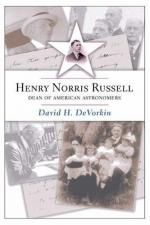|
This section contains 398 words (approx. 2 pages at 300 words per page) |
World of Scientific Discovery on Henry Norris Russell
Henry Russell was born on October 25, 1877, in Oyster Bay, New York. He received his higher education at Princeton University and had earned his Ph.D. by the age of 23. He became the director of Princeton's observatory in 1912.
During the course of his observations, Russell discovered a relationship between a star's color (or, analogously, its spectral class), and its brightness. Blue stars were hottest, yellow stars were cooler and red stars were coolest. In general, blue stars should be the brightest and red stars the dimmest, but there were exceptions--some red stars were very bright. For a cool, red star to appear bright, Russell reasoned that it either had to be very close or very large. A star with a large surface area could radiate a significant amount of light at low temperatures, so those very bright stars had to be giants. Hence, he called these stars red giant stars.
Armed with observations of a large number of stars, Russell created a diagram on which the stars' spectral classification, roughly equivalent to temperature, was plotted along the x-axis, and their luminosity was plotted along the y-axis. On this diagram, most stars fell along a diagonal line running from upper left (the hottest, brightest stars) to lower right (the coolest, faintest stars). The stars on this diagonal line were called main sequence stars. These are healthy, stable stars like the Sun. Stars not on the main sequence are typically those in advanced stages of stellar evolution, such as the red giants or supergiants.
As it turned out, this same relationship had been discovered by Danish astronomer Ejnar Hertzsprung nearly ten years earlier but had received no publicity. To remedy this oversight, the chart was called the Hertzsprung-Russell diagram, honoring the work of both men. The H-R diagram was used to deduce the path of stellar evolution and it worked fairly well for 25 years. When scientists like Hans Bethe began to work out the mechanics of the nuclear energy that powered the stars, the physical mechanisms that produced the elegant realtionships on the H-R diagram were at last uncovered. By the end of the twentieth century, many variants on the original H-R diagram had been developed, to accommodate the various new observational parameters that had become available. Nevertheless, the essential character of the original diagram remained, having served as a useful tool for stellar astronomers for nearly a century.
|
This section contains 398 words (approx. 2 pages at 300 words per page) |


